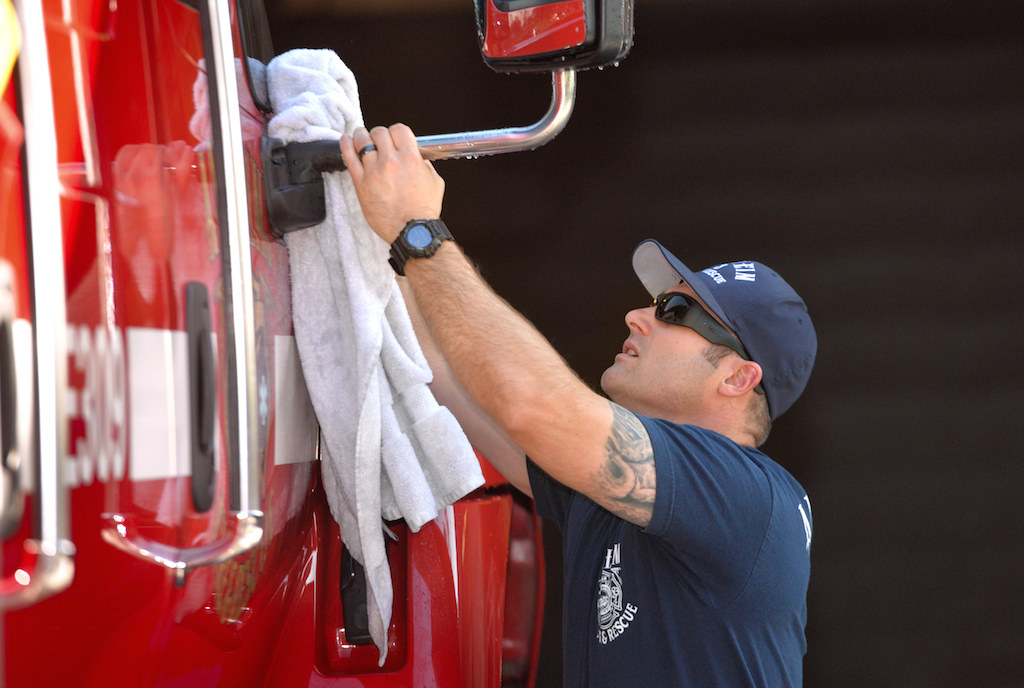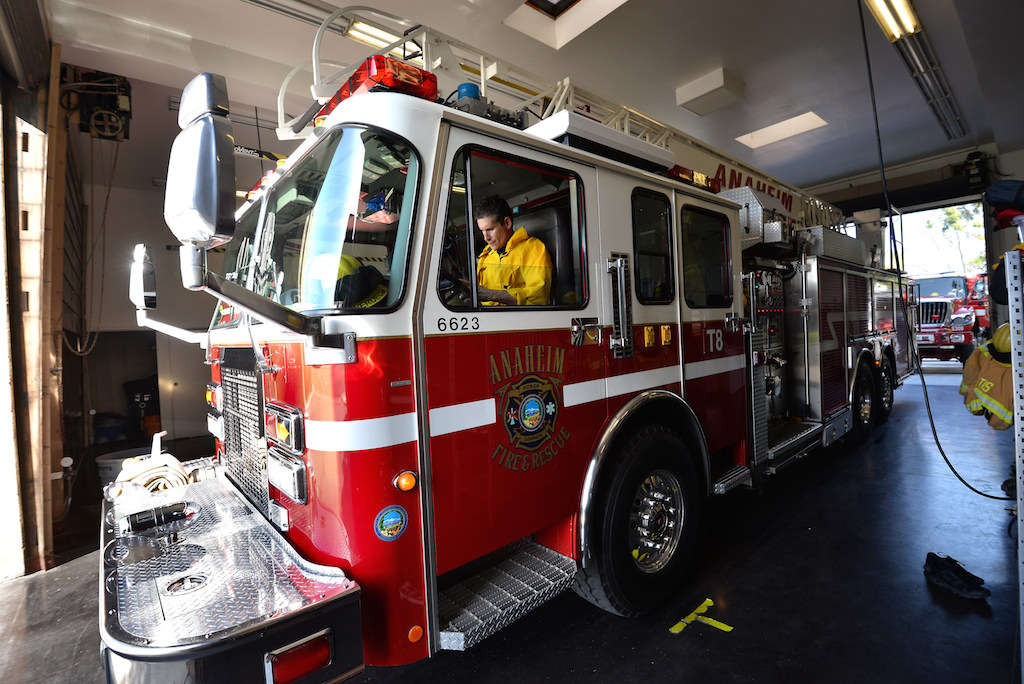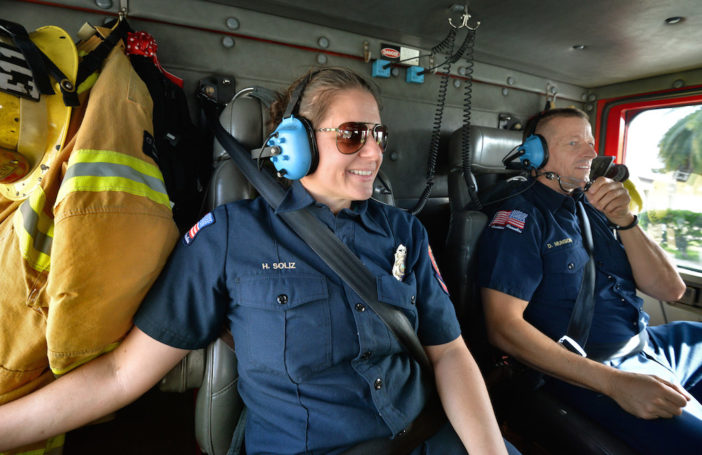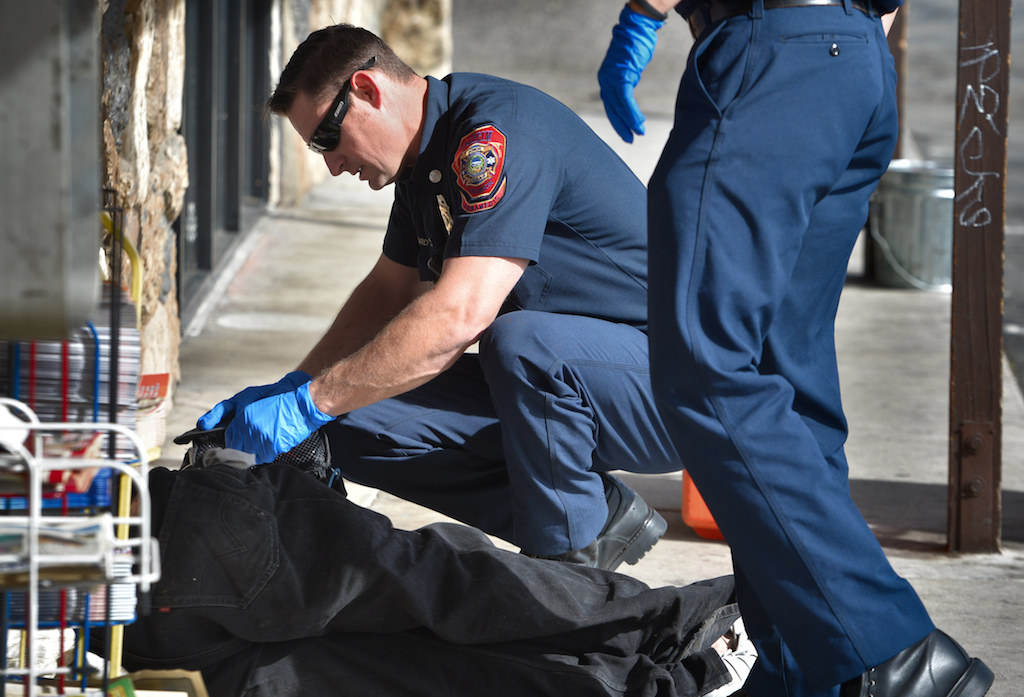The firefighter stirred the simmering soup on the stove in Station 11.
Tonight’s “chow” is chicken and dumpling soup — one of Firefighter Paramedic Heather Soliz’s specialties.
Suddenly, a call comes in.
Medical aid.
A person is lying in the gutter at Ball Road and Beach Boulevard.
Soliz briskly moves away from the stove to join her colleagues – an engineer, a captain and a fellow paramedic – inside Engine 11, a 40,000-lb. piece of equipment that is equipped with a hose, a pump and a variety of tools and equipment to handle all types of emergencies.
Their goal, as always, is to be out of the station in 60 to 90 seconds.
Soliz didn’t have to worry about turning off the stove. That happened automatically when the call came in — a nifty feature in Anaheim’s newer fire stations. Every time a call comes in, the gas cuts off as a safety precaution.
A firefighter’s shift is never “routine” or “normal,” because every day can be different.

Engineer Paramedic Rob Fry of Anaheim Fire & Rescue pulls Engine 11 into a local hospital as he follows an ambulance transporting a patient with his fellow paramedics riding in the ambulance.
Photo by Steven Georges/Behind the Badge OC
Firefighters can be slammed with back-to-back-to-back calls or keep busy around the station with training, maintenance and other duties for hours before the next call comes in during their 24-hour shifts.
Sleep usually is possible, but almost always in spurts.
“Chowtime,” as firefighters call it, often is interrupted.
And you “go when you have to go” in case you get stuck on a long call — and grab quick showers when you can.
“You have to be fluid,” Soliz says, meaning ready to drop whatever you’re doing to bolt off on a call.
Sometimes, within minutes, firefighters must go from a deep slumber to carrying 70 pounds of equipment on their backs and wielding heavy hoses to knock down a blaze.
Staying fit is critical.
And being ready for anything is the norm.

Chris Fulkerson, a firefighter engineer at Station 8, cleans a rig during a recent shift. Photo: Steven Georges
On a recent weekday, Capt. Greg Fox fills in at Station 11 as shift supervisor.
“I’ve gotten calls when I’ve been in the shower and I’m wiping shaving cream off my face on my way to the scene,” Fox says.
Behind the Badge OC recently spent several hours shadowing firefighters at Station 11, which handles multiple calls every day in the densely populated, westernmost edges of the city, and Station 8, on the city’s east side off the 91 Freeway.
Station 8 is close to lots of open space — the playground of hikers, mountain bikers and runners, and potential tinderboxes during fire season.
The rhythm at Station 8 is different from the typically steady stream of calls that come into Station 11, which is surrounded by convalescent homes and near Beach Boulevard — the scene of many traffic accidents.
“We may not have a lot of quantity when it comes to calls, but we tend to respond to serious calls here at Station 8,” Firefighter Kevin Harris says, referring to emergencies requiring major response — the school bus crash on Nohl Ranch Road, for example, on April 24, 2014 that injured 12.
The public may not realize it, but more than 80 percent of calls that come into Anaheim’s 11 fire stations — and fire stations throughout the county and elsewhere — are for emergency medical aid.
Chest pains.
Breathing problem.
Seizures.

Capt. Michael Byard, a firefighter paramedic with Anaheim Fire & Rescue’s Station 11, logs in information from the scene of a call on an iPad, which automatically uploads the info to the department’s database with the tablet’s built-in cellular connection.
Photo by Steven Georges/Behind the Badge OC
These and other calls are far more common than actual fires — and one of the reasons two Anaheim Fire & Rescue firefighter paramedics are assigned to every response unit except two truck companies, which will have paramedics assigned by the end of the year.
Firefighter paramedics have more training than firefighters who are EMTs (all firefighters are EMTs, actually, including engineers — the firefighters who drive the engines and trucks).
Paramedics are trained in Advance Life Support (ALS) to handle the most serious calls, in addition to BLS (Basic Life Support) for such injuries as broken bones. BLS equipment also includes facemasks for dogs and cats to prevent smoke inhalation.
At Station 8, Firefighter James Moreta is finalizing a schedule for countywide wildland fire training sessions as Firefighter Paramedic Dan Lambert makes a healthy salad of tuna, broccoli, apple, spinach, tomatoes and other veggies.
The firefighters gather to eat, some of them stuffing the finely chopped salad into pita bread and spicing it up with Tapatio sauce.
The person in the gutter on Beach Boulevard turns out to be a 61-year-old male familiar to firefighters and cops.

Capt. Mike Byard, left, and Firefighter Denny Munson of Anaheim Fire & Rescue’s Station 11 respond to a medical call in Cypress. Firefighter crews are no longer limited to their own city as dispatchers can send the closest available unit, cutting down on response times.
Photo by Steven Georges/Behind the Badge OC
Because the man is unable to tell firefighters where he is, Soliz and Engineer Paramedic Rob Fry ride in the back of a Care ambulance as he is taken to a nearby emergency room. That’s the protocol when a person is too incapacitated to function, Fox explains. The two EMTs Soliz and Fry ride with, Michael Stokes and Brad Beaman, work out of Station 11 but are employees of Care Ambulance Service.
On another medical aid call, the Station 11 crew is dispatched to a home for people with late-stage dementia. A woman has fallen out of her wheelchair.
They check on her and she is not seriously hurt, but they take her to the hospital as a precaution because her blood sugar is elevated.
The details of each station call are recorded on an iPad, which is the county’s electronic reporting system (EPER) that is linked to the Metro Net Communications Center and the county Emergency Medical Services (EMS).
Cancellations happens a lot when firefighters are en route to a call.
Fox and his team have time to swing by a local “gourmet” fast-food restaurant, Paul’s Place, at Knott and Cerritos Avenues in Cypress, for takeout food. They call the place “Paul’s and Calls” because most times while eating there, a call comes in.

Firefighter Engineer and Paramedic David Verdecia of Anaheim Fire & Rescue Station 8 logs in his last call during a recent shift.
Photo by Steven Georges/Behind the Badge OC
On this day, the firefighters take their food back to Station 11 and scarf it down there.
At Station 11 and Station 8, as soon as they are done eating, the firefighters immediately clean up to bring the kitchens back to their usual spic-and-span conditions.
Cleaning is a regular duty for firefighters — though they aren’t complete neat freaks, Fox says. Today is windows and walls day at Station 11.
“My philosophy,” Fox says, “is ‘clean enough to be healthy, dirty enough to be happy.’”
“Dirty” is an overstatement. For visitors to Station 11 (and Station 8), the place looks pristine.
Station 11 is one of three in Anaheim that has an “extractor” — a heavy-duty washer for turnouts that get soiled with debris from fires and medical aid calls that normal washing machines can’t clean. Firefighters from other Anaheim stations drop off their badly soiled turnouts at Station 11.
The crew at Station 11 eventually gets to enjoy Soliz’s chicken and dumpling soup.

Capt. Jerry George, left, and Firefighter James Moreta of Anaheim Fire & Rescue Station 8 stand in front of Engine 309, a Type 3 rig designed to fight wildfires, at Starr Ranch where the fire department often trains.
Photo by Steven Georges/Behind the Badge OC
The firefighters take turns cooking, but seem to particularly love her meals.
Firefighters pay for their own food and “staples” — another thing the public may not realize.
And rescuing cats from trees?
That’s just a cliché, Fox says.
“After all,” he asks, “have you ever seen a skeleton of a cat in a tree?”
 Behind the Badge
Behind the Badge




